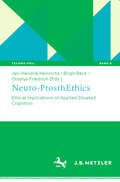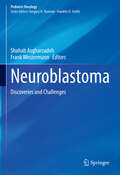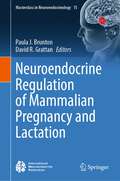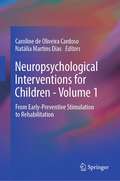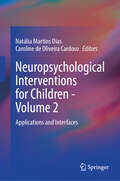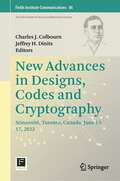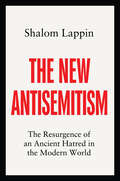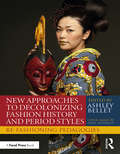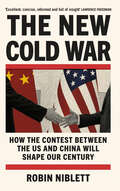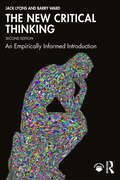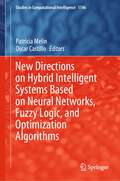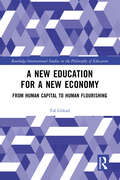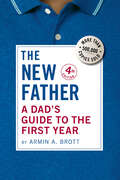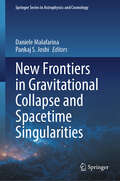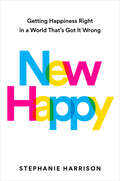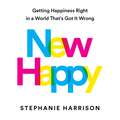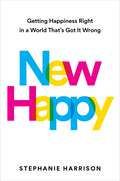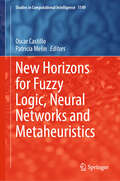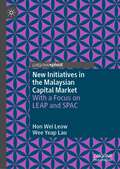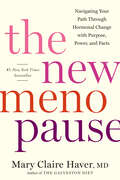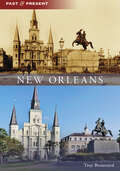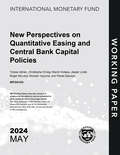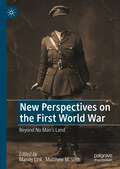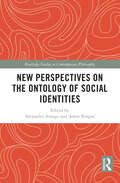- Table View
- List View
Neuro-ProsthEthics: Ethical Implications of Applied Situated Cognition (Techno:Phil – Aktuelle Herausforderungen der Technikphilosophie #9)
by Jan-Hendrik Heinrichs Birgit Beck Orsolya FriedrichThe volume focusses on the ethical dimensions of the technological scaffold embedding human thought and action, which has been brought to attention of the cognitive sciences by situated cognition theories. There is a broad spectrum of technologies co-realising or enabling and enhancing human cognition and action, which vary in the degree of bodily integration, interactivity, adaptation processes, of reliance and indispensability etc. This technological scaffold of human cognition and action evolves rapidly. Some changes are continuous, some are eruptive. Technologies that use machine learning e.g. could represent a qualitative leap in the technological scaffolding of human cognition and actions. The ethical consequences of applying situated cognition theories to practical cases had yet to find adequate attention and are elucidated in this volume.
Neuroblastoma: Discoveries and Challenges (Pediatric Oncology)
by Shahab Asgharzadeh Frank WestermannThis book provides a state-of-the-art review of the biology, treatment, and other critical aspects of neuroblastoma, reflecting the dramatic advances that have been achieved in understanding and management. Topics are arranged according to the book’s dominant themes of the “seed” (tumor genomics, epigenetics, metabolism, and stem cells) and the “soil” (tumor microenvironment, adaptive and innate immunity, and exosomes) and how both of these influences can serve as rich targets for intervention, whether by targeted molecular therapy or immunotherapy. Therapeutic strategies that are currently in use or under consideration for the future are discussed in detail, with the focus on precision medicine. Further individual chapters are devoted to the biology and genetics of relapsed/refractory neuroblastoma and emerging methods of evaluating tumor burden. Finally, in keeping with the, albeit modest, increase in cure rates in high-risk disease, immune and cellular therapies are reviewed. This coverage of what is becoming a not-so-enigmatic tumor will appeal to a broad readership including both experimental oncologists and clinicians who care for patients with neuroblastoma.
Neuroendocrine Regulation of Mammalian Pregnancy and Lactation (Masterclass in Neuroendocrinology #15)
by David R. Grattan Paula J. BruntonAdaptations to maternal physiology are required for a successful pregnancy outcome. These changes are primarily orchestrated by the mother’s brain and involve multiple neuroendocrine systems. For this book, the editors have gathered internationally recognized experts who have contributed to the major advances in our understanding of different aspects of the neuroendocrine regulation of mammalian pregnancy and lactation. The book begins with a discussion of how pregnancy is recognized and maintained and the role of the placental hormones in supporting key adaptations required for a successful pregnancy. The next few chapters focus on the neuroendocrine adaptations that occur during pregnancy in some key regulatory processes to ensure a sufficient supply of energy and nutrients, protect the fetus from potentially harmful maternal stress hormones, and prepare mammals for birth, milk production, lactation and motherhood. Finally, our current understanding of how the significant peripartum hormonal changes contribute to the mother’s cognitive function and mood is examined. This book provides a broad overview of the finely orchestrated neuroendocrine adaptations that occur in pregnancy and lactation and discusses how such changes contribute to maximizing the likelihood of a positive outcome for mother and infant. Importantly the evidence for involvement of neuroendocrine dysregulation in some pregnancy-related complications, such as preterm birth and perinatal mood disorders is also highlighted. In addition to addressing fundamental mechanisms in the regulation of mammalian pregnancy and lactation, the book includes the most recent advances in the field made possible by utilizing the latest innovative research technologies. Moreover, it provides opinions on optimal experimental approaches, relates findings from experimental animal models with those from humans, and outlines the direction and opportunities for future research in this arena. It is an essential resource for undergraduate students, postgraduate students, and early career researchers embarking upon their journey in the fields of neuroendocrinology, endocrinology, reproductive biology or behavioural neuroscience. It also provides a valuable synopsis for established neuroendocrine researchers and educators, especially those whose interest transcends the nexus between neuroendocrinology and reproductive biology. This is the 15th volume in the International Neuroendocrine Federation (INF) “Masterclass in Neuroendocrinology” series, which aims to illustrate the highest standards and to encourage the use of the latest technologies in basic research and hopes to provide inspiration for further exploration into the exciting field of neuroendocrinology.
Neuropsychological Interventions for Children - Volume 1: From Early-Preventive Stimulation to Rehabilitation
by Caroline de Oliveira Cardoso Natália Martins DiasThis book is the first of two volumes that aim to serve as a comprehensive guide for professionals working with neuropsychological interventions especially designed for children. This first volume presents the theoretical foundations, tips and guidelines for neuropsychologists to develop different interventions, such as stimulation and early intervention with a focus on promoting neuropsychological health; habilitation, appropriate for work with neurodevelopment disorders; and rehabilitation, in cases of structural alterations. In this sense, it reflects the editors' concern to provide material with practical tips, but theoretically grounded, and truly useful to professionals in clinical and also school contexts. This first volume is divided into two parts. The first addresses the theoretical and practical foundations of child neuropsychological assessment and intervention. Neuropsychological assessment is discussed, with a focus on its role in guiding intervention. Also, different types of interventions are presented, and a taxonomy is offered, according to its differential objectives of promotion or remediation and the target population (typical development, functional or structural alterations of the Nervous System), leading to the suggestion of three types of interventions in neuropsychology in both clinical and school contexts: 1) Early preventive Intervention; 2) Habilitation and 3) Rehabilitation. Cognitive stimulation in different contexts, such as school, family and clinical, is also discussed, exploring how teachers and parents can also collaborate in intervention processes, expanding the possibilities for action beyond the clinical context. A section concludes by addressing the importance of the feedback and the neuropsychological assessment report.The second part focuses specifically on stimulation and rehabilitation, offering chapters that target specific skills such as attention, memory, executive functions and academic skills, among others. The chapters summarize evidence, bring tips and illustrate existing materials and programs, in a continuous articulation between theory-evidence-practice. Originally published in Portuguese and now available in English, Neuropsychological Interventions for Children – Volumes 1 and 2 will be of interest to professionals working with neuropsychology in clinical and school contexts. It will also be useful in neuropsychology teaching contexts (specialization courses in neuropsychology and related areas) and for students and professionals in interface areas, such as Psychology, Education, Speech Therapy, Occupational Therapy among others. The translation of the original Portuguese version of this book into English was done with the help of artificial intelligence. A subsequent human revision was done primarily in terms of content.
Neuropsychological Interventions for Children - Volume 2: Applications and Interfaces
by Caroline de Oliveira Cardoso Natália Martins DiasThis book is the second of two volumes that aim to serve as a comprehensive guide for professionals working with neuropsychological interventions especially designed for children. This second volume complements the theoretical and practical foundations presented in the first volume by presenting applications to different clinical conditions and by exploring interfaces of neuropsychology with other areas of research and practice. Chapters in this second volume are divided into two parts. The first part presents a series of case studies, illustrating the practice and experience of neuropsychological rehabilitation and habilitation in different clinical conditions. The second part brings together chapters that discuss the interfaces of neuropsychology with different areas, which can use its knowledge and interventions (such as school neuropsychology) or which can be used as strategies within neuropsychological intervention or even compose inter and transdisciplinary partnerships in the work of promotion, stimulation, or cognitive remediation, such as the use and role of music, games and play, mindfulness, and transcranial direct current stimulation. So, chapters in this second part highlight the interfaces with other approaches, knowledges or disciplines. Originally published in Portuguese and now available in English, Neuropsychological Interventions for Children – Volumes 1 and 2 will be of interest to professionals working with neuropsychology in clinical and school contexts. It will also be useful in neuropsychology teaching contexts (specialization courses in neuropsychology and related areas) and for students and professionals in interface areas, such as Psychology, Education, Speech Therapy, Occupational Therapy among others. The translation of the original Portuguese version of this book into English was done with the help of artificial intelligence. A subsequent human revision was done primarily in terms of content.
New Advances in Designs, Codes and Cryptography: Stinson66, Toronto, Canada, June 13-17, 2022 (Fields Institute Communications #86)
by Charles J. Colbourn Jeffrey H. DinitzThis volume records and disseminates selected papers from the Stinson66 conference, including surveys, prospectives, and papers presenting original and current research. It contains four accessible surveys of topics in combinatorial designs and related topics, ranging from a tutorial survey of connections to classical group theory, to surveys of "hot topics" in current research. It also contains a prospective paper identifying topics for future research efforts, co-authored by one of the elder statesmen of the field, Alex Rosa. Finally, the research papers examine topics ranging from pure mathematics to applied work in computing, networking, communications, and cryptography. For students and newcomers to these topics, the volume provides accessible survey material that does not have onerous prerequisites. The breadth of topics reflects the vibrancy of the field in a way that can be appreciated by all researchers. The papers present important advances on theory and applications,which also benefit advanced researchers.
The New Antisemitism: The Resurgence of an Ancient Hatred in the Modern World
by Shalom LappinGenerations raised after the Second World War took for granted a world of stability and prosperity, and with it the waning of ancient hatreds. Recent decades have been more sobering. Instability and extremism have returned in force. As Shalom Lappin explains in this worrying book, an upsurge of antisemitism across the political spectrum has accompanied them. Recent events in the Middle East have transformed it into a tidal wave. Lappin explores in particular the disturbing correlation between the expansion of economic globalization and the return of the anti-Jewish ideas that we thought had been consigned to the past. He examines this relationship within the context of the assault on democracy and social cohesion that anti-globalist reactions have launched in different parts of the world. To understand contemporary antisemitism, Lappin argues, it is essential to recognize the way in which its antecedents have become deeply embedded in Western and Middle Eastern cultures over millennia. This allows hostility to Jews to cross political boundaries easily, left and right, in a way that other forms of racism do not. Combatting antisemitism effectively requires a new progressive politics that addresses its root causes. The New Antisemitism is crucial reading for anyone concerned with the social pathologies unleashed by our current economic and political discontents.
New Approaches to Decolonizing Fashion History and Period Styles: Re-Fashioning Pedagogies
by Ashley BelletNew Approaches to Decolonizing Fashion History and Period Styles: Re-Fashioning Pedagogies offers a wide array of inclusive, global, practical approaches for teaching costume and fashion history.Costume designers, technicians, and historians have spent the last several years re-evaluating how they teach costume and fashion history, acknowledging the need to refocus the discourse to include a more global perspective. This book is a collection of pedagogical methods aimed to do just that, with an emphasis on easy reference, accessible activities, and rubrics, and containing a variety of ways to restructure the course. Each chapter offers a course description, syllabus calendar, course objectives, and learning outcomes, as well as sample activities from instructors across the country who have made major changes to their coursework. Using a combination of personal narratives, examples from their work, bibliographies of helpful texts, and student responses, contributors suggest a variety of ways to decolonize the traditionally Western-focused fashion history syllabus.This collection of pedagogical approaches is intended to support and inspire instructors teaching costume design, costume history, fashion history, period styles, and other aesthetic histories in the arts.
The New Cold War: How the Contest Between the US and China Will Shape Our Century
by Robin NiblettAn urgent and essential assessment of the global contest between the US and China, and how looking to history will help us to navigate it, from former Director of Chatham House"An illuminating book for the interested citizen as well as for those making policy" - Hillary Rodham Clinton We have entered a new Cold War. The contest between America and China is global and unbridgeable, and it encompasses all major instruments of statecraft - economic, political and military. It has its tinder box: Taiwan. And both protagonists are working hard to draw allies to their side from across the world. We stand at its beginning. But this Cold War is nothing like the conflict between the Soviet Union and the West which defined the second half of the twentieth century. We need new ideas to navigate its risks and avoid a globally devastating hot war. In this urgent and necessary book, Robin Niblett argues that only by looking back can we learn the lessons to guide us through this new reality: he goes through the ten ways in which the New Cold War is different and offers five rules for navigating its onset. How we manage this contest will determine not only whether there is still space for international cooperation to deal with our many global challenges, from the climate emergency to the technological revolution, but also who will lead the twenty-first century and, quite simply, the course of all our futures.
The New Critical Thinking: An Empirically Informed Introduction
by Jack Lyons Barry WardThis book aims to improve real-world critical thinking.Traditional critical thinking texts neglect two crucial facts. First, as psychologists have shown, many of our mistakes are caused not by faulty formal reasoning but because we bypass it in favor of intuitive, often unreliable heuristics. Second, good critical thinking requires not only the proper assessment of inference but also of our premises: the evaluation of information sources is of fundamental importance, especially in this internet era of fake news and politicized science.This highly innovative text is psychologically informed, both in its diagnosis of inferential errors and in teaching students how to watch out for, and circumnavigate, their natural intellectual blind spots. It also incorporates insights from epistemology and philosophy of science to formulate best practices for assessing information sources on the internet and other media. The result is a practical, hands-on primer for real-world critical thinking.The authors bring more than five combined decades of classroom experience to the subject, covering the usual core topics of deductive, inductive, causal, and probabilistic inference, argument identification, reconstruction, and diagramming, while also extending the text’s scope to include testimony, the nature and credibility of science, rhetoric, and dialectical argumentation.The Second Edition further develops and refines these innovations, combining in-depth discussion of “fake news” and conspiracy theories with exercises and projects designed to teach broadly applicable source assessment skills. There is also a more nuanced positive account of science that emphasizes its continuity with commonsense causal reasoning. For instructors, there are additional online resources, notably banks of exam questions with solutions and various class projects.Key Features: Uses contemporary psychological explanations and remedies for pervasive errors in belief formation. No other critical thinking text generally applies this psychological approach Rigorously addresses the evaluation of premises based on testimony, in particular the testimony of internet sources Carefully explains the concept of validity, paying particular attention to distinguishing logical possibility from other species of possibility Uses frequency trees as a simple and reliable alternative to more complicated Bayesian methods Uses arguments maps, which improve students’ reasoning and argument evaluation Key Updates to the Second Edition: Expanded discussion of the psychology of reasoning and belief, including treatment of motivated reasoning Uses a conventional truth-table–based approach to propositional logic while incorporating a more intuitive, psychologically informed approach to the logic of conditionals New Summary Boxes Enhanced treatment of testimony, with an expanded discussion of fake news, conspiracy theories, and the application of general epistemic principles to navigate the extremes of gullibility and unmotivated skepticism. New exercises that emphasize practical, hands-on source assessment skills An improved discussion of the nature of science emphasizing the central role of causal inference and the multi-generational, cumulative character of scientific knowledge A new Index of Arguments, summarizing the most common argument forms and associated defeaters for the inductive forms New online content, including exams and additional questions (plus solutions), suitable for upload to course management software (e.g., Blackboard, etc.) For online resources suitable for students and instructors, please see the appropriate link on the book’s Routledge web page: www.routledge.com/9781032317281
New Directions on Hybrid Intelligent Systems Based on Neural Networks, Fuzzy Logic, and Optimization Algorithms (Studies in Computational Intelligence #1146)
by Patricia Melin Oscar CastilloThis book contains a collection of papers focused on hybrid intelligent systems based on soft computing techniques. In this book, new directions on the theoretical developments of fuzzy logic, neural networks and optimization algorithms, as well as their hybrid combinations, are offered. In addition, the abovementioned methods are discussed in application areas such as control and robotics, pattern recognition, medical diagnosis, decision-making, prediction and optimization of complex problems. There are a group of papers with the main theme of type-1, type-2 and type-3 fuzzy logic, which basically consists of papers that propose new concepts and algorithms based on type-1, type-2 and type-3 fuzzy logic and their applications. There is also a set of papers that offer theoretical concepts and applications of meta-heuristics in different areas. Another group of papers outlines diverse applications of hybrid intelligent systems in real problems. There are also some papers that presenttheory and practice of neural networks in different applications. Finally, there are papers that offer theory and practice of optimization and evolutionary algorithms in different application areas
A New Education for a New Economy: From Human Capital to Human Flourishing (Routledge International Studies in the Philosophy of Education)
by Tal GileadProviding an in-depth, novel analysis of education’s role in today’s economy by scrutinizing its theoretical underpinnings, this volume critiques the suitability of the current, dominant economic framework for education and for shaping educational policymaking worldwide.Critically examining the history and philosophy that underpin our present societal understanding of the link between economics and education, the book argues for an urgent redefining of education’s role in the economy based on intellectual foundations that significantly differ from our current, dominant conceptions. Across seven chapters, the book posits that the adoption of a new philosophical framework, the reshaping of economic and educational aims, and the adjustment of our educational system are each necessary to better promote human flourishing.Ultimately providing a platform to entirely reconsider the idea that the primary aim of education is to serve the economic system – in particular, economic growth – this book will appeal to scholars, researchers, and postgraduate students studying educational policy, the philosophy of education, and the history of education more broadly. Education policymakers and academics studying education and the economy may also find this book of interest.
The New Father: A Dad's Guide To The First Year (The New Father #0)
by Armin A. BrottThe best-selling guide to the first year of fatherhood, trusted by hundreds of thousands of new dads and their partners This indispensable handbook, from the author of the million-selling Expectant Father, provides a reassuring month-by-month overview of your baby’s first year. It covers the milestones in your child’s development; ways you can bond with your child and support your partner; and what’s going on with you, as a new dad. The fourth edition of The New Father features a user-friendly new design and is updated from cover to cover with the latest information about healthcare, financial planning, parental leave and work-life balance, and much more. It incorporates the expertise of leading pediatricians and researchers, and the real-life experiences of hundreds of dads and moms. Illustrated with stress-relieving cartoons, The New Father is a friendly, readable, and inclusive companion for all new dads. (Moms will love it, too!)
New Frontiers in Gravitational Collapse and Spacetime Singularities (Springer Series in Astrophysics and Cosmology)
by Pankaj S. Joshi Daniele MalafarinaThe book collects a series of articles to review the advances that have been made in the field of gravitational collapse in general relativity and alternative theories of gravity in the past few years. Many approaches to black hole and singularity formation in general relativity and beyond have been proposed over the last few decades. The importance of collapse models is that they provide natural thought experiments where to test the behavior and properties of a variety of approaches to general relativity and its implications for ultra-compact objects in the universe.
The New Girl: A Graphic Novel (New Girl Ser.)
by Cassandra CalinInstagram sensation and Tapas webcomic superstar Cassandra Calin makes her long-form debut with this funny, feel-good middle-grade graphic novel about change.Goodbye, old life...Lia and her family are waiting to board a flight across the Atlantic, leaving behind family, friends, and Romania -- the only home Lia has ever known. But Lia's heartache is overshadowed by the discomfort of her first period. As if things weren't difficult enough! Now Lia is thrust into a world where everything is different: her home, her language, and even her body. With so many changes happening at once, Lia struggles with schoolwork, has trouble communicating with classmates, and has no idea how to manage her unpleasant periods. Will she ever feel like herself again?Inspired by the author's own immigration experience, The New Girl is a comically charming story about change and acceptance.
New Happy: Getting Happiness Right in a World That's Got It Wrong
by Stephanie HarrisonA NEXT BIG IDEA CLUB MUST-READ Well-being expert and social media sensation Stephanie Harrison of @newhappyco reveals the counterintuitive secrets to happiness and provides a practical guide to help us all learn how to live a happy life.We all want to be happy, but happiness always seems to be out of reach — until now. In New Happy, happiness expert Stephanie Harrison draws upon hundreds of studies to offer a life-changing guide to finding the happiness you have been looking for, all based on a decade of research and brought to life with beautiful artwork. It&’s not your fault if you are unhappy. You have been told three lies: you&’re not good enough; you need to achieve fame, wealth, and power; and you need to do it all on your own. This is Old Happy, our society&’s false definition of happiness, and it&’s making us miserable. In this book, you&’ll learn the truth: you are enough, you have unique and important gifts, and using them to help other people leads to your happiness. New Happy is your step-by-step guide to building the life you want. Accompanied by revelatory artwork that explains key concepts, Harrison takes you through the process of unwinding Old Happy, uncovering your own gifts, and using them to both improve your life and the world at the same time. If you have ever asked yourself, &“Who am I really?&” &“When will I be happy?&” or &“What am I supposed to do with my life?&” this book is for you.Through an inspiring blend of art and science, New Happy will forever change the way that you see yourself and the world. Whether you&’re wondering what career you should choose, navigating a life transition, going through a difficult time, teaching your kids what matters most, or simply hoping to experience more joy every day, New Happy offers the proven path to a happier life and a better world.
New Happy: Getting Happiness Right in a World That's Got It Wrong
by Stephanie HarrisonWe all want to be happy. This goal drives everything that we do. Why, then, are so many of us so unhappy? It's not your fault. You have been told a lie: that achieving your own success will make you happy. This is "old happy," society's incorrect definition of happiness.The truth is that happiness comes from helping other people to live happier lives. Accompanied by revelatory artwork that explains key concepts, New Happy takes you through the process of unwinding Old Happy, uncovering your own gifts, and using them to both improve your life and the world at the same time. If you have ever asked yourself, "Who am I really?" "When will I be happy?" or "What am I supposed to do with my life?" this book is for you.Through an inspiring blend of art and science, New Happy will forever change the way that you see yourself and the world. Whether you're wondering what career you should choose, navigating a life transition, going through a difficult time, teaching your kids what matters most, or simply hoping to experience more joy every day, New Happy offers the proven path to a happier life and a better world.
New Happy: Getting Happiness Right in a World That's Got It Wrong
by Stephanie HarrisonWe all want to be happy. This goal drives everything that we do. Why, then, are so many of us so unhappy? It's not your fault. You have been told a lie: that achieving your own success will make you happy. This is "old happy," society's incorrect definition of happiness.The truth is that happiness comes from helping other people to live happier lives. Accompanied by revelatory artwork that explains key concepts, New Happy takes you through the process of unwinding Old Happy, uncovering your own gifts, and using them to both improve your life and the world at the same time. If you have ever asked yourself, "Who am I really?" "When will I be happy?" or "What am I supposed to do with my life?" this book is for you.Through an inspiring blend of art and science, New Happy will forever change the way that you see yourself and the world. Whether you're wondering what career you should choose, navigating a life transition, going through a difficult time, teaching your kids what matters most, or simply hoping to experience more joy every day, New Happy offers the proven path to a happier life and a better world.
New Horizons for Fuzzy Logic, Neural Networks and Metaheuristics (Studies in Computational Intelligence #1149)
by Oscar Castillo Patricia MelinThis book contains a collection of papers focused on hybrid intelligent systems based on soft computing techniques. In this book, new horizons on the theoretical developments of fuzzy logic, neural networks and optimization algorithms are envisioned. In addition, the abovementioned methods are discussed in application areas such as control and robotics, pattern recognition, medical diagnosis, decision-making, prediction and optimization of complex problems. There are a group of papers with the main theme of type-1, type-2 and type-3 fuzzy systems, which basically consists of papers that propose new concepts and algorithms based on type-1, type-2 and type-3 fuzzy logic and their applications. There is also a group of papers that offer theoretical concepts and applications of meta-heuristics in different areas. Another group of papers outlines diverse applications of hybrid intelligent systems in real problems. There are also a group papers that present theory and practice of neural networks in different applications. Finally, there are papers that offer theory and practice of optimization and evolutionary algorithms in different application areas.
New Initiatives in the Malaysian Capital Market: With a Focus on LEAP and SPAC
by Hon Wei Leow Wee Yeap LauThis book covers the most recent initiatives in the Malaysian capital market. In doing so, it discusses the Leading Entrepreneur Accelerator Platform Market (LEAP Market), and Special Purpose Acquisition Company (SPAC).With regard to the LEAP Market, the book elaborates on its inception, value proposition, governance, performance, issues, and strengths. It also compares LEAP Market with the Main and ACE Markets, and draws the experience of the Korea New Exchange (KONEX) for LEAP Market to emulate and improve its operation, showing how KONEX provides valuable lessons for Malaysia's LEAP Market, as the former has two times more listed firms than the latter. Similarly, the book also includes discussions on the inception of SPAC, its features, volumes, risk, issues, strength, life cycle and time frame of SPAC IPO, and includes case studies of the four firms listed under SPAC IPO. Put together, the book offers a compilation of facts, analysis and insights from these new market initiatives, and provides a reference for the financial market industry, regulators, market practitioners, analysts, researchers, government authorities and universities.
The New Menopause: Navigating Your Path Through Hormonal Change with Purpose, Power, and Facts
by Mary Claire Haver#1 NEW YORK TIMES BESTSELLER • Filling a gaping hole in menopause care, everything a woman needs to know to thrive during her hormonal transition and beyond, as well as the tools to help her take charge of her health at this pivotal life stage—by the bestselling author of The Galveston Diet.Menopause is inevitable, but suffering through it is not! This is the empowering approach to self-advocacy that pioneering women&’s health advocate Dr. Mary Claire Haver takes for women in the midst of hormonal change in The New Menopause. A comprehensive, authoritative book of science-backed information and lived experience, it covers every woman's needs:• From changes in your appearance and sleep patterns to neurological, musculoskeletal, psychological, and sexual issues, a comprehensive A to Z toolkit of science-backed options for coping with symptoms.• What to do to mediate the risks associated with your body's natural drop in estrogen production, including for diabetes, dementia, Alzheimer&’s, osteoporosis, cardiovascular disease, and weight gain.• How to advocate and prepare for annual midlife wellness visits, including questions for your doctor and how to insist on whole life care.• The very latest research on the benefits and side effects of hormone replacement therapy.Arming women with the power to secure vibrant health and well-being for the rest of their lives, The New Menopause is sure to become the bible of midlife wellness for present and future generations.
New Perspectives on Quantitative Easing and Central Bank Capital Policies
by ZabczykA report from the International Monetary Fund.
New Perspectives on the First World War: Beyond No Man’s Land
by Mandy Link Matthew M. StithTaken collectively, the chapters in New Perspectives on the First World War: Beyond No Man’s Land not only illuminate pieces of the Great War that remain in the shadow of the broader narratives, but also, and more importantly, foster new perspectives, pose distinct questions, and suggest fresh directions from which future work might emerge. Transnational approaches, the cultural and environmental history of war, and gender’s ubiquitous but heretofore marginalized role in the larger conflict together merit fresh research and careful new interpretation.
New Perspectives on the Ontology of Social Identities (Routledge Studies in Contemporary Philosophy)
by Alejandro Arango and Adam BurgosThis volume presents new research in social ontology by focusing on questions related to the characteristics, categories, and conceptual methodologies surrounding social identities, in general, and specific social identities, in particular.The volume contains eight original essays, plus a foreword written by Linda Martín Alcoff, that engage with issues pertaining to a broad range of identities, including class, sexuality, gender, race, ethnicity, and religious identity. This collection is an abrebocas, an entry way to theorizing about social identities in novel ways, and the essays collected here point to specific modes of understanding and experiencing social identities that have not been given their due or that offer new approaches to well-worn topics.New Perspectives on the Ontology of Social Identities will appeal to scholars and advanced students across several philosophical disciplines, such as philosophy of race, feminist philosophy, social and political philosophy, phenomenology, epistemology, and social ontology. Scholars in disciplines like psychology, religious studies, and other social sciences will also find new approaches to questions of social identity relevant to understanding the complexity of the social world.
